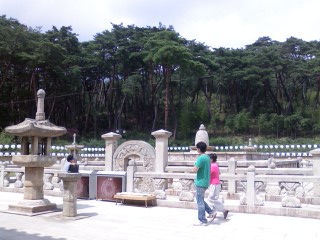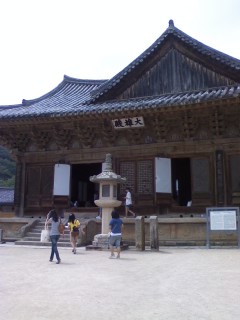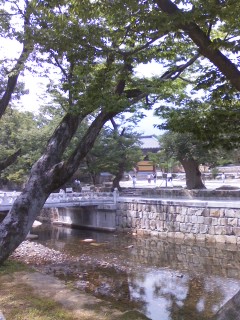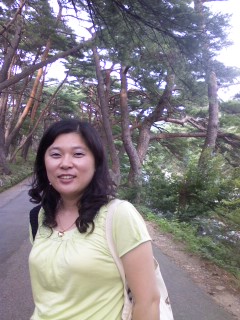Tongdosa (Temple), YeongChuksan (Mt.).
- Location: Jisan-ri, Habuk-myeon, Yangsan
- Phone: 055)382-4112
- Transportation: Busan Bus Terminal (Nopodong Subway Station, Gyeongnam Bus) -> To Sinpyeong (Tongdosa (Temple)) (Time 6|30~21|00 / Every 20 minutes) -> Tongdosa (Temple) Chunil Express bus to Busan and get off at Tongdosa (Temple) Interchange -> Tongdosa (Temple)
Tongdosa (Temple) located in YeongChuksan (Mt.). is a thousand year old temple founded by Jajang (monk) in 15th year of Queen Seondeok (Year 646) of Silla Dynasty and it is the head temple of Gyeyul and is one of the three famous temples in Korea. It's character is that there is only a Buddhist alter without an image of Buddha and it enshrines a relic of the Buddha at the main temple and Geumgang Commandments Altar (National Treasure No 290).
This temple has the most number of tangible Buddhist cultural artifacts (43 types) among Korean temples and 19 small temples are located within the thick forests of YeongChuksan (Mt.). near the temple. It is famous for its tracking courses since many hikers visit YeongChuksan (Mt.). which enfolds Tongdosa (Temple) as if embracing and in harmony with cliffs of fantastic rocks and stones.
This temple has the most number of tangible Buddhist cultural artifacts (43 types) among Korean temples and 19 small temples are located within the thick forests of YeongChuksan (Mt.). near the temple. It is famous for its tracking courses since many hikers visit YeongChuksan (Mt.). which enfolds Tongdosa (Temple) as if embracing and in harmony with cliffs of fantastic rocks and stones.
Tongdosa (Temple)
Specialities | Wild edible greens, acorn-starch jelly, Codonopsis lanceolata
A thousand year old temple located within in YeongChuksan (Mt.) and it is one of the three temples with three treasures (Buddha, the law of Buddha and a Buddhist monk) in Korea enshrining the relic of the Buddha.
Jajang (monk) who headed to Dang (China) for religious study founded the temple on 15th year of Queen Sunduk (Year 646) of Silla Dynasty by bringing the relic of the Buddha. Since that day, the lantern has never been extinguished for 1,3000 years and there is only a Buddhist alter without an image of Buddha in the main temple and it enshrines a relic of the Buddha at Geumgang Commandments Altar. Tongdosa (Temple) has the most number of tangible Buddhist cultural artefacts (43 types) among Korean temples and Tongdosa (Temple) Sungbo Museum newly opened in April 15 1999 is the only museum exclusively for Buddhist paintings in the world.
Iljumoon (Single Column Gate)
This gate is the first gate to the temple and its characteristic is that the columns are arranged in a single line. Ilju (一住 - Single Column) means the arrangement of columns but the actual meaning is originated from ‘Bupwhagyung (the Sutra of the Lotus)'. It originated from the great cause of Bupwhagyung of ‘Gather Three and Return back to One (會三歸一)’ which means gather 'Three Ascensions' and return back to 'One Ascension' which is the greatest ascension. The caligraphy on the hanging board hung in front reads YeongChuksan (Mt.) Tongdosa (Temple) written by Heungsun Daewongun and the verse on a pillar is by Heagang Kim Gyujin and it reads as 'Buljijongga (佛之宗家) Gukjidaechal (國之大刹)'.
Statues of The Four Devas
The statues of the Four Devas are gods governing four regions of East, West, South and North which are the lowest regions of the Heaven and Earth. These statues are said to be erected in the middle of Chosun Dynasty.
The Main Temple and Geumgang Commandments Altar (National Treasure No 290)
The Main Temple is installed with Geumgang Commandments Altar hosting the relics of the Buddha thus a separate image of Buddha was not hosted. Geumgang Commandments Altar means strong and precious commandments like diamonds.
It symbolizes that Buddha is always there and the present Geumgang Commandments Altar was repaired throughout Goryo·Chosun Dynasty. The relics of Buddha is kept in a bell-shaped stone structure in the middle of Geumgang Commandments Altar. The inside of 1st pillar is engraved with a celestial being and the outside is engraved with Sakra, a guardian god of protecting Buddhism. Geumgang Commandments Altar is praised as an important cultural artefacts in terms of construction structures and studies on the history of construction as well as the meaning that the Commandments has.
Geumgang Commandments Altar
The founding spirit of Tongdosa (Temple) lies with the Geumgang Commandments Altar enshrining the relics of Buddha. The reason that Tongdosa (Temple) has become the temple based on Buddhist Commandments of Silla Dynasty is because being commanded from Geumgang Commandments Altar where the relics of Buddha are enshrined has the same meaning as actually being commanded by Buddha himself.
Guryongsinjin (Nine Dragon Pond)
It is located to the west of the Main Temple and the pond is oval in shape with the size of 13~17m2 and a stone bridge is constructed above. It contains the myth on the foundation of Tongdosa (Temple).
Bongbaltop (Monk's Wooden Rice Bowl Pagoda) (Treasure No 471)
A stone Bongbaltop (Monk's Wooden Rice Bowl Pagoda) with the height of 2m in front of Yongwhajeon of Jungrojeon is constructed by creating rice bowls of enlightened person as tally of Buddha expecting the appearance of Maitreya (the Merciful Buddha).
First, a lower stone is placed on top of a fountain. Then an octagonal stone is put in place. Finally a top stone is placed on the octagonal stone with a covered bowl.
It is shaped like a stone lantern at a glance but it is special that lighting place is located at the foot. This stone Bongbal (wooden rice bowl) is believed to be originated from the Buddhist scripture of 'the disciples of Buddha is waiting to present rice bowl of Buddha to Maitreya (the Merciful Buddha) who will appear in the world to come.'
Three-story Stone Pagoda (Treasure No 1471)
This stone pagoda featuring the characteristics of the end of Unified Silla Dynasty is a normal three-story stone pagoda created by layering 3 stories of spire on 2 stories of base on top of a huge base stone and it is 3.9m tall. It is an important material for understanding masonry historical properties of Tongdosa (Temple) along with worshipping stone in front of the pagoda.
Temple Stay at Tongdosa (Temple)
- Temple stay is experiencing daily lives of a monk and resting minds and experiencing traditional culture in a temple where nature and Buddhism is in harmony.
A day at a temple beings with the sound of a bell notifying morning prayers and having meal with clean food and creating spiritual richness through meditation while sitting upright. Sometimes, one can free oneself from daily matters while taking walks on quiet and still forest roads or create precious relationship while enjoying a cup of tea.
Temple stay is a process of finding oneself with the mind of becoming one with the nature along with the beautiful smell of traditional culture forgotten from our lives. - Program : Praying, meditation, meal with rice bowls (traditional way of having meals by monks), tea ceremony, early morning walks.







No comments:
Post a Comment